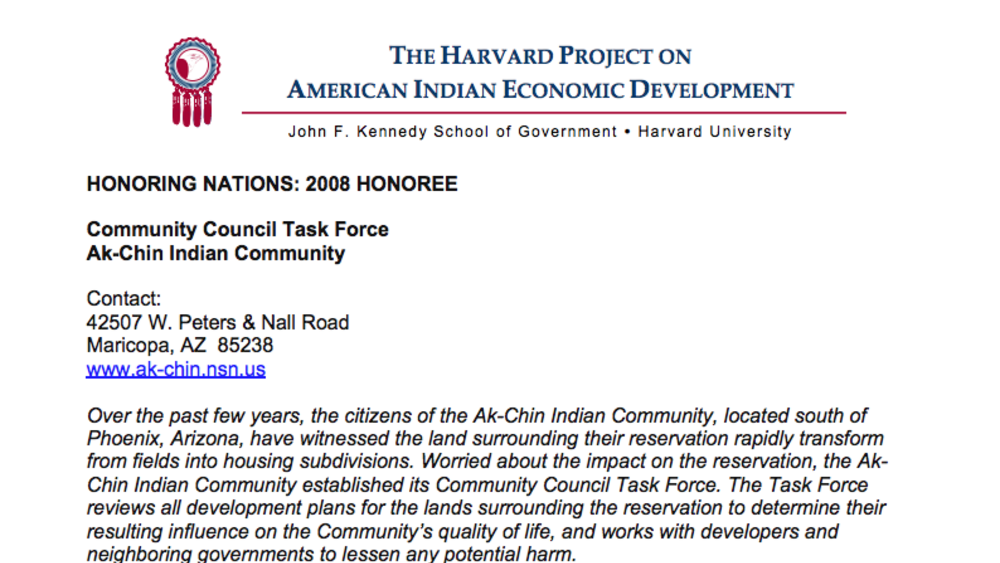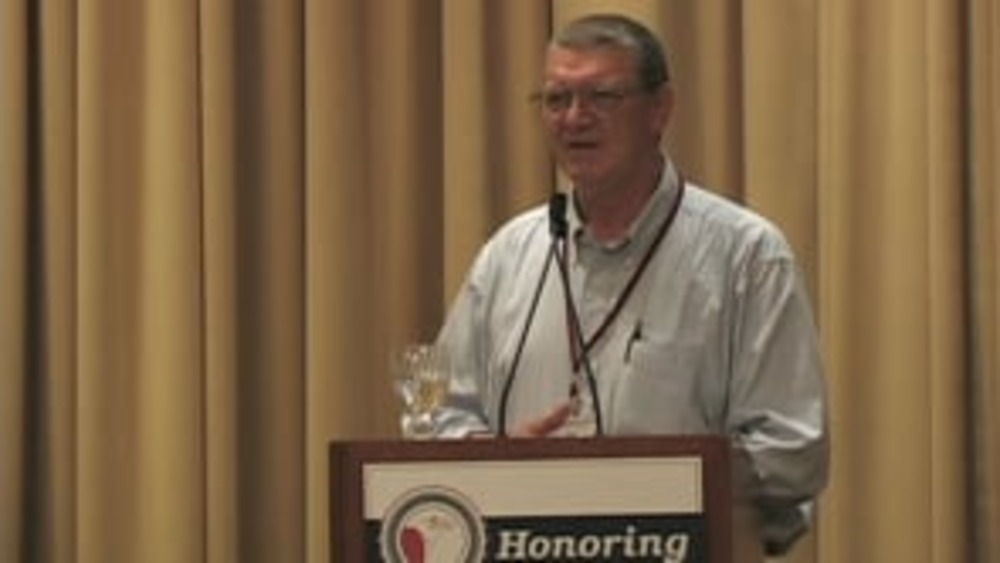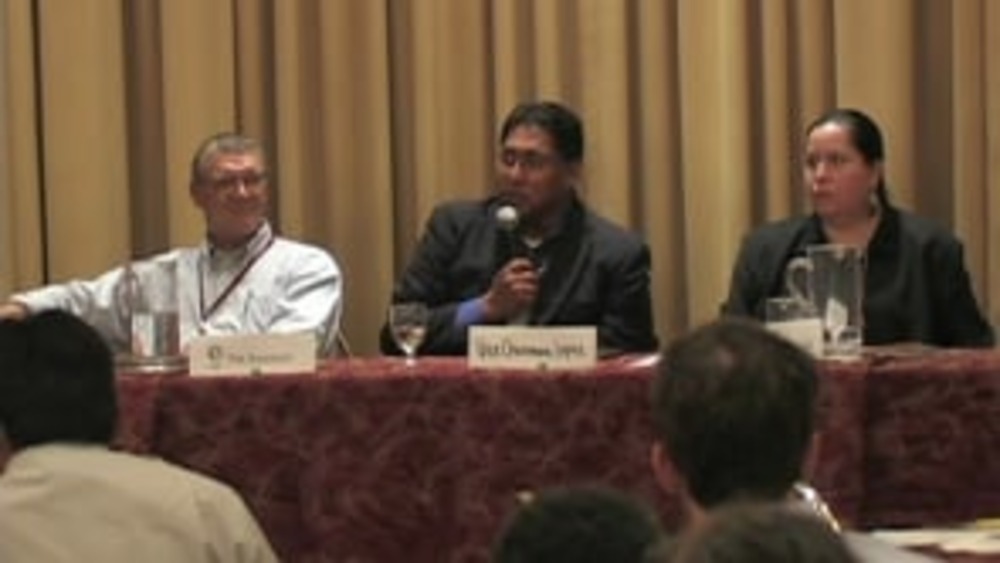Ak-Chin Indian Community Council Member Gabriel Lopez discusses why the Community decided to establish the Ak-Chin Community Council Task Force, and shares how the Task Force works to protect the cultural and environmental integrity of the Ak-Chin community, reservation and surrounding lands.
Additional Information
Lopez, Gabriel. "Ak-Chin Community Council Task Force." Honoring Nations symposium. Harvard Project on American Indian Economic Development, John F. Kennedy School of Government, Harvard University. Cambridge, Massachusetts. September 18, 2009. Presentation.
Transcript
"...I'd like to say my name is Gabriel Lopez and I say good morning -- it's still morning back home. Good afternoon. I am currently the Vice Chairman of Ak-Chin Indian Community. It's a great honor to be here and to tell our story of the work that we're doing back home in our community. Just to give you a brief overview of our community, our community is one of 22 tribal communities within the State of Arizona. We are located approximately 40 miles southwest of Phoenix, Arizona, within Pinal County. Our reservation is composed of 21,840 acres, 14,000 of it is dedicated to [agriculture]. The community is governed by a five-member council. The community has 849 enrolled members. Eighty-five percent of them are still living within the reservation. For numerous years, the community has been located in a rural setting with an agricultural foundation, which continues today and will into the future. The issues impacting our community -- in October of 2003, the town of Maricopa was incorporated as the 88th city within the State of Arizona with a population of approximately 3,500. With this incorporation, progressed to a sudden urbanization due to the vast hyper growth surrounding the Ak-Chin reservation. In 2008, the population increased to 45,571 residents. From 2004 to 2005, there were 26 residential subdivisions that were constructed surrounding the community. Let alone in 2005, there were 17 City of Maricopa planning and zoning cases. Additionally, there were special requests such as improvements to washes, widening of highways, reduction of agricultural land that are beneficial to their development needs upstream and downstream from the community. These improvements would all end at the community boundary. In January of 2006, the community learned through Pinal County Zoning and Planning [department] and also the Central Arizona Association Governments of an additional permit use request to involve construction of a water reclamation facility, Campus Two. The community was not against the construction of the campus, but was opposed to discharge of effluent water within the tributaries -- the Vekol Wash, the Santa Cruz Canal -- which flow through the Ak-Chin Indian reservation. This facility would treat 13 million gallons per day at build out. Along with the wastewater facility, the utility proposed construction of four additional reclamation facilities located south of the Ak-Chin reservation. Campus Five would discharge into Vekol Wash at build out [and] would treat 22 million gallons. Campus Six would discharge into Santa Cruz Wash, Santa Rosa Canal at 21 million gallons of water. Campus Seven would discharge also in the Santa Cruz Wash and would treat 18 million gallons of water per day. Campus Three would discharge into Santa Cruz Wash at build out 50 million gallons. These residential developments and waterways improvement [could] potentially and negatively impact the community culturally, economically and environmentally. Some of the impacts of concern to discharge were the quality of water is stagnant, erosion, cultural impacts, judicial matters, [and] lack of monitoring or enforcement. With all the impacts surrounding the community, the Ak-Chin Indian Community Council in 2006 created a task force to investigate all development. The community council appointed members to sit on a task force. The task force consisted of cultural resources, environmental and planning departments, and at times [the] legal [department] and members of the Ak-Chin Farms board. The task force would review neighboring city and/or Pinal County planning and zoning cases. After review of these cases, the task force would provide recommendation to the council for final decision. The task force periodically would attend planning and zoning meetings in the city and/or state to provide comments verbally or written in various cases. The task force's goal is to protect and preserve the community's resources. Now, the city, county and state, private companies coordinate and communicate with the Community [on] potential impacts. The State of Arizona Department of Environmental Quality has recently changed their surface water quality standards to eliminate all new discharges into washes that transect into the community. The private utility company that proposed to discharge effluent water into our washes didn't. An MOU was signed and now [it] has become a friend of the community. Now the City Council and the Community Council meet on a quarterly basis to discuss upcoming projects and development surrounding the community. I know it's a short and brief presentation, and a lot of times what happens on a quarterly basis, we meet with the Maricopa City Council and our tribal council to discuss developments that may occur. A lot of times we have to go into MOUs because of all of the development that's currently around our community. We have to think about burial agreements, because it's -- what we say is we have boundaries, but it's the boundaries put up by the federal government, but they don't understand about ancestral lands which goes beyond our boundaries. Several years ago, about two years ago, Qwest was running a fiber-optic line from one community to another. It so happens that we have an understanding with the city that our culture resources [department] have monitoring individuals that stay and monitor there, but on that day the two that were monitoring, this trench had to go to training, but the company had their own archaeologist there, and it was about maybe two feet down that they actually kind of chipped, hit what they thought was a pot. So the cultural resources director -- she's female. Back home, what we do is when we deal with stuff like that, it's the men that actually go out and retrieve whatever we need to retrieve. On that day she called me and I got hold of my uncle. We went out to investigate and after further excavation, we found out it was a cremation. So it was still intact, we excavated the cremation, brought it back to the community and safeguarded [it] that way. And that way it worked. We also expressed to the City Council that any development that happens or occurs even with private developers, that we need that burial agreement because of such cases as this and what those mean to us. With this case, as I wrap up my presentation, I'd just like to give a quote as one of the elders had said at one of the hearings is that, 'We value the washes like Vekol Wash, which means 'great-grandfather' to us, it's because it gives us the beginning of our ancestors to provide water when it rains for our crops, for their survival, that's what got us here and that's who we are today.' Thank you."



